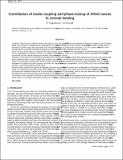Files in this item
Contribution of mode-coupling and phase-mixing of Alfvén waves to coronal heating
Item metadata
| dc.contributor.author | Pagano, P. | |
| dc.contributor.author | De Moortel, I. | |
| dc.date.accessioned | 2017-03-23T15:30:11Z | |
| dc.date.available | 2017-03-23T15:30:11Z | |
| dc.date.issued | 2017-05-12 | |
| dc.identifier | 249465573 | |
| dc.identifier | f3ab4669-8b35-4a78-a818-9441234b370e | |
| dc.identifier | 85019635862 | |
| dc.identifier | 000402313500107 | |
| dc.identifier.citation | Pagano , P & De Moortel , I 2017 , ' Contribution of mode-coupling and phase-mixing of Alfvén waves to coronal heating ' , Astronomy & Astrophysics , vol. 601 , A107 . https://doi.org/10.1051/0004-6361/201630059 | en |
| dc.identifier.issn | 0004-6361 | |
| dc.identifier.other | ORCID: /0000-0002-1452-9330/work/39526508 | |
| dc.identifier.uri | https://hdl.handle.net/10023/10517 | |
| dc.description | This research has received funding from the European Research Council (ERC) under the European Union’s Horizon 2020 research and innovation programme (grant agreement No. 647214) and from the UK Science and Technology Facilities Council. This work used the DiRAC Data Centric system at Durham University, operated by the Institute for Computational Cosmology on behalf of the STFC DiRAC HPC Facility (www.dirac.ac.uk. This equipment was funded by a BIS National E-infrastructure capital grant ST/K00042X/1, STFC capital grant ST/K00087X/1, DiRAC Operations grant ST/K003267/1 and Durham University. | en |
| dc.description.abstract | Context. Phase-mixing of Alfvén waves in the solar corona has been identified as one possible candidate to explain coronal heating. While this scenario is supported by observations of ubiquitous oscillations in the corona carrying sufficient wave energy and by theoretical models that have described the concentration of energy in small-scale structures, it is still unclear whether this wave energy can be converted into thermal energy in order to maintain the million-degree hot solar corona. Aims. The aim of this work is to assess how much energy can be converted into thermal energy by a phase-mixing process triggered by the propagation of Alfvénic waves in a cylindric coronal structure, such as a coronal loop, and to estimate the impact of this conversion on the coronal heating and thermal structure of the solar corona. Methods. To this end, we ran 3D MHD simulations of a magnetised cylinder where the Alfvén speed varies through a boundary shell, and a footpoint driver is set to trigger kink modes that mode couple to torsional Alfvén modes in the boundary shell. These Alfvén waves are expected to phase-mix, and the system allows us to study the subsequent thermal energy deposition. We ran a reference simulation to explain the main process and then we varied the simulation parameters, such as the size of the boundary shell, its structure, and the persistence of the driver. Results. When we take high values of magnetic resistivity and strong footpoint drivers into consideration, we find that i) phase-mixing leads to a temperature increase of the order of 105 K or less, depending on the structure of the boundary shell, ii) this energy is able to balance the radiative losses only in the localised region involved in the heating, and iii) we can determine the influence of the boundary layer and the persistence of the driver on the thermal structure of the system. Conclusions. Our conclusion is that as a result of the extreme physical parameters we adopted and the moderate impact on the heating of the system, it is unlikely that phase-mixing can contribute on a global scale to the heating of the solar corona. | |
| dc.format.extent | 1131304 | |
| dc.language.iso | eng | |
| dc.relation.ispartof | Astronomy & Astrophysics | en |
| dc.subject | Sun: corona | en |
| dc.subject | Sun: oscillations | en |
| dc.subject | Sun: magnetic fields | en |
| dc.subject | Magnetohydrodynamics (MHD) | en |
| dc.subject | Waves | en |
| dc.subject | QB Astronomy | en |
| dc.subject | QC Physics | en |
| dc.subject | NDAS | en |
| dc.subject.lcc | QB | en |
| dc.subject.lcc | QC | en |
| dc.title | Contribution of mode-coupling and phase-mixing of Alfvén waves to coronal heating | en |
| dc.type | Journal article | en |
| dc.contributor.sponsor | Science & Technology Facilities Council | en |
| dc.contributor.sponsor | European Research Council | en |
| dc.contributor.institution | University of St Andrews. Applied Mathematics | en |
| dc.contributor.institution | University of St Andrews. School of Mathematics and Statistics | en |
| dc.identifier.doi | https://doi.org/10.1051/0004-6361/201630059 | |
| dc.description.status | Peer reviewed | en |
| dc.identifier.grantnumber | ST/N000609/1 | en |
| dc.identifier.grantnumber | 647214 | en |
This item appears in the following Collection(s)
Items in the St Andrews Research Repository are protected by copyright, with all rights reserved, unless otherwise indicated.

